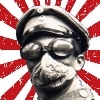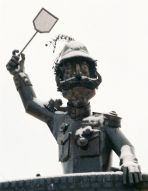- Fleetwing
- Typewriter Talk Vet
 Offline
Offline - From: Hartford, CT USA
- Registered: 30-6-2015
- Posts: 1,021
Re: What's your favorite way of cleaning crinkle paint?
The crinkle paint hides fingerprint marks, I think. And maybe there's the fact it doesn't produce reflections -- easier on the eyes of the typist.
- Uwe
- Moderator
 Offline
Offline 
- From: Toronto, Canada
- Registered: 12-3-2013
- Posts: 4,410
Re: What's your favorite way of cleaning crinkle paint?
Wrinkle paint is (was) used because it hides small imperfections in metal cases, and is supposed to be a more durable paint finish.
The pronoun I has always been capitalized in the English language for more than 700 years.
- thetypewriterman
- Key Master
 Offline
Offline - From: Leiston, England
- Registered: 29-5-2013
- Posts: 942
Re: What's your favorite way of cleaning crinkle paint?
Yes, a good example of this is the Imperial Typewriter Company who were one of the few typewriter manufacturers to continue throughout the war. They switched from the glossy black enamel finish to crackle finish black on all their models in 1940 and never went back. I'm pretty sure that it was because the castings did not have to be linished and polished to a super-high standard (as when using gloss black enamel) because crackle finish will hide a multitude of small imperfections. For the same reason, rebuilt secondhand typewriters of all makes were 'modernised' with this finish in the late 1940's.
- M. Höhne
- Key Master
 Offline
Offline - From: Maine
- Registered: 14-3-2013
- Posts: 646
Re: What's your favorite way of cleaning crinkle paint?
Uwe wrote:
Wrinkle paint is (was) used because it hides small imperfections in metal cases, and is supposed to be a more durable paint finish.
I am sure that another reason is simply fashion and to signal to potential to buyers that "our product has something different." Of course at some point every brand has it and that's where the fashion comes in.
For cleaning it, I find Scrubbing Bubbles or your local clone of it works dramatically well but you should keep it away from decals, especially the gold ones, and use it in a well-ventilated area.
- skywatcher
- Moderator
 Offline
Offline - From: The Prairies of Alberta
- Registered: 14-3-2013
- Posts: 742
Re: What's your favorite way of cleaning crinkle paint?
Greetings All The thing I’ve found and like about Scrubbing Bubbles is the almost instant indication of how dirty the finish is. When first sprayed on, the foam is white but will turn varying shades of yellow through brown depending on how much dirt and or nicotine has accumulated on the finish. A quick scrub with a reasonably soft bristled brush followed by a rinse off with a spray of hot water and the finish is pretty well clean. Just dry it thoroughly and you’re ready to reassemble. All the best, Sky
We humans go through many computers in our lives, but in their lives, typewriters go through many of us.
In that way, they’re like violins, like ancestral swords. So I use mine with honor and treat them with respect.
I try to leave them in better condition than I met them. I am not their first user, nor will I be their last.
Frederic S. Durbin. (Typewriter mania and the modern writer)
- Captain Spencer
- New Member
 Offline
Offline - Registered: 20-1-2016
- Posts: 7
Re: What's your favorite way of cleaning crinkle paint?
Hey y'all- my first post on the forum! I'm new to typewriter restoration, but so far I've found warm water and Mr. Clean Magic Eraser is doing the trick beautifully.
- malole
- Inactive Account
 Offline
Offline 
- From: East Anglia, UK
- Registered: 02-6-2014
- Posts: 330
Re: What's your favorite way of cleaning crinkle paint?
I read somewhere in the typosphere about using toothpaste and a toothbrush, so I gave it a go. It does take patience, but at least you know nothing horrible will come of it. Plus you get the minty aroma!
- Uwe
- Moderator
 Offline
Offline 
- From: Toronto, Canada
- Registered: 12-3-2013
- Posts: 4,410
Re: What's your favorite way of cleaning crinkle paint?
Isn't toothpaste a mild abrasive? I like the idea of a soft bristle toothbrush - I always have a couple in the toolbox - but not sure about the toothpaste. I'll stick to using a household cleaner designed for cleaning grease and stains off of painted surfaces and my trusted cotton swabs. Not the fastest method, but it's safe and very effective.
The pronoun I has always been capitalized in the English language for more than 700 years.
- retro
- Platen Punisher
 Offline
Offline 
- From: Suffolk, England
- Registered: 11-2-2015
- Posts: 66
Re: What's your favorite way of cleaning crinkle paint?
Uwe wrote:
Isn't toothpaste a mild abrasive? I like the idea of a soft bristle toothbrush - I always have a couple in the toolbox - but not sure about the toothpaste.
Toothpaste is slightly abrasive, I used to use it to clean the chrome on my motorcycle and cars. It was a lot cheaper than using chrome polish and worked just as well. I have always cleaned the letter slugs with methylated spirits and a toothbrush. I have no idea what it might do to the paint finish on a 1930's typewriter but I always used to put a drop of meths in a bucket of water when leathering off the cars after the weekly wash to prevent any water marks. It certainly didn't seem to do any harm to the Rolls Royce or the Bentley I had to clean every Sunday morning in my youth. I always use a non abrasive polish, Simoniz Original, probably the hardest car polish to use though but my typewriters are gleaming bright if nothing else.
- NDW76
- Platen Punisher
 Offline
Offline - From: Bangkok
- Registered: 18-8-2014
- Posts: 86
Re: What's your favorite way of cleaning crinkle paint?
I have used the tooth brush and mild dish soap method on a RQD. After it was clean I gave it a coat of Renaissance Wax with a stiff paint brush. Looks great now.
Pleased to meet you. Call me Nathan.


